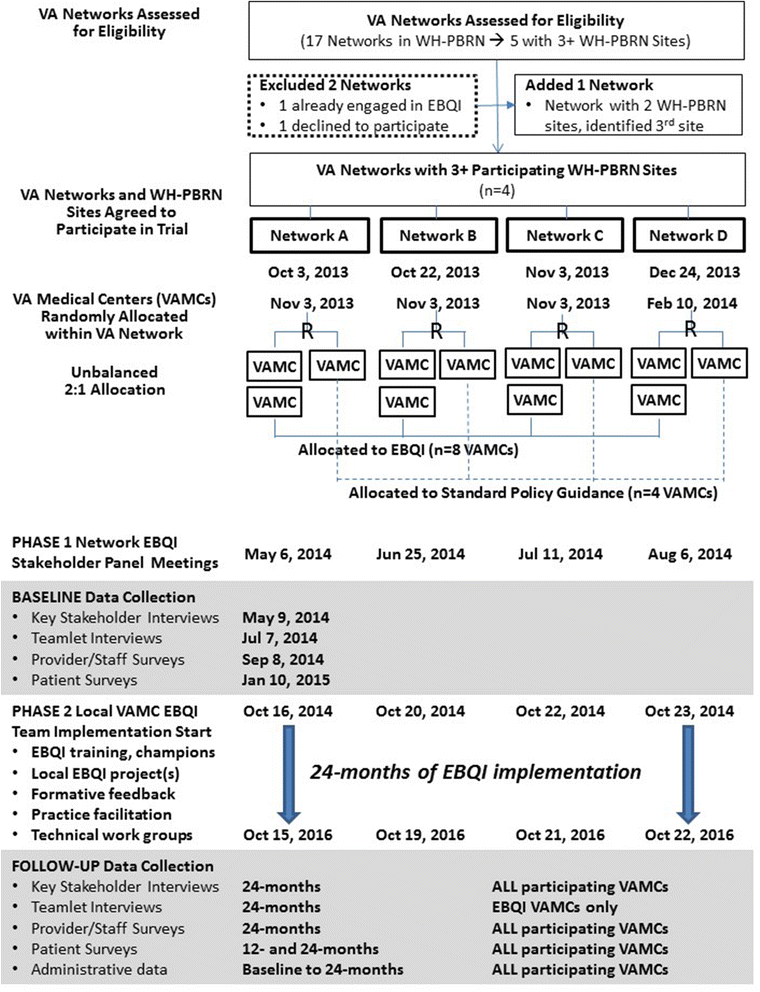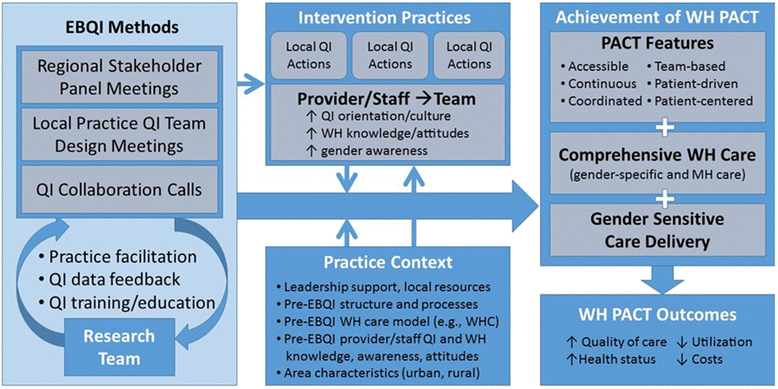Cluster randomized trial of a multilevel evidence-based quality improvement approach to tailoring VA Patient Aligned Care Teams to the needs of women Veterans
- PMID: 27435723
- PMCID: PMC4950741
- DOI: 10.1186/s13012-016-0461-z
Cluster randomized trial of a multilevel evidence-based quality improvement approach to tailoring VA Patient Aligned Care Teams to the needs of women Veterans
Abstract
Background: The Veterans Health Administration (VA) has undertaken a major initiative to transform care through implementation of Patient Aligned Care Teams (PACTs). Based on the patient-centered medical home (PCMH) concept, PACT aims to improve access, continuity, coordination, and comprehensiveness using team-based care that is patient-driven and patient-centered. However, how VA should adapt PACT to meet the needs of special populations, such as women Veterans (WVs), was not considered in initial implementation guidance. WVs' numerical minority in VA healthcare settings (approximately 7-8 % of users) creates logistical challenges to delivering gender-sensitive comprehensive care. The main goal of this study is to test an evidence-based quality improvement approach (EBQI) to tailoring PACT to meet the needs of WVs, incorporating comprehensive primary care services and gender-specific care in gender-sensitive environments, thereby accelerating achievement of PACT tenets for women (Women's Health (WH)-PACT).
Methods/design: EBQI is a systematic approach to developing a multilevel research-clinical partnership that engages senior organizational leaders and local quality improvement (QI) teams in adapting and implementing new care models in the context of prior evidence and local practice conditions, with researchers providing technical support, formative feedback, and practice facilitation. In a 12-site cluster randomized trial, we will evaluate WH-PACT model achievement using patient, provider, staff, and practice surveys, in addition to analyses of secondary administrative and chart-based data. We will explore impacts of receipt of WH-PACT care on quality of chronic disease care and prevention, health status, patient satisfaction and experience of care, provider experience, utilization, and costs. Using mixed methods, we will assess pre-post practice contexts; document EBQI activities undertaken in participating facilities and their relationship to provider/staff and team actions/attitudes; document WH-PACT implementation; and examine barriers/facilitators to EBQI-supported WH-PACT implementation through a combination of semi-structured interviews and monthly formative progress narratives and administrative data.
Discussion: Lack of gender-sensitive comprehensive care has demonstrated consequences for the technical quality and ratings of care among WVs and may contribute to decisions to continue use or seek care elsewhere under the US Affordable Care Act. We hypothesize that tailoring PACT implementation through EBQI may improve the experience and quality of care at many levels.
Trial registration: ClinicalTrials.gov, NCT02039856.
Keywords: Evidence-based quality improvement; Implementation; Patient-centered medical home; Veterans; Women’s health.
Figures



References
-
- U.S. General Accounting Office . Actions needed to ensure that female veterans have equal access to VA benefits. Washington, DC: GAO Publications; 1982.
-
- Veterans Health Administration . Sourcebook: women veterans in the Veterans Health Administration. Volume 1: sociodemographic characteristics and use of VHA care. Washington, DC: Department of Veterans Affairs; 2010.
-
- Yano EM, Rose D, Bean-Mayberry B, Canelo I, Washington DL. Impact of practice structure on the quality of care for women veterans (phase 2) final report. Sepulveda, CA: VA HSR&D Center of Excellence for the Study of Healthcare Provider Behavior; 2010.
-
- Veterans Health Administration . Report to the Appropriations Committee of the U.S. House of Representatives in response to House Appropriations Report No. 110–186, accompanying Public Law 110–161, The Consolidated Appropriations Act. Washington, DC: Department of Veterans Affairs; 2008.
Publication types
MeSH terms
Associated data
Grants and funding
LinkOut - more resources
Full Text Sources
Other Literature Sources
Medical
Miscellaneous

